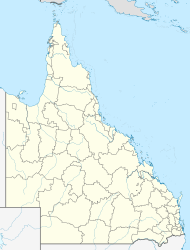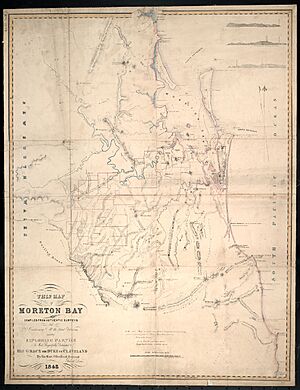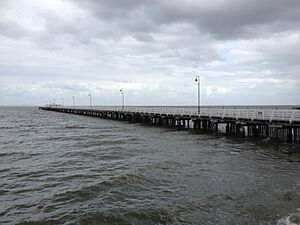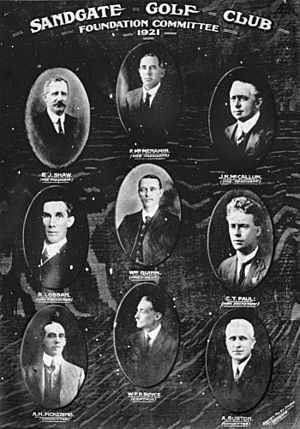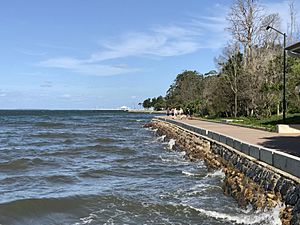Shorncliffe, Queensland facts for kids
Quick facts for kids ShorncliffeBrisbane, Queensland |
|||||||||||||||
|---|---|---|---|---|---|---|---|---|---|---|---|---|---|---|---|
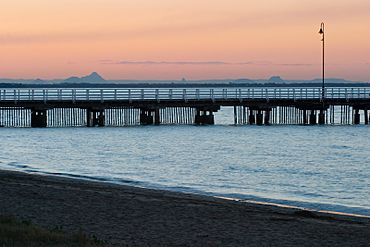
Shorncliffe pier in the evening
|
|||||||||||||||
| Population | 1,907 (2021 census) | ||||||||||||||
| • Density | 1,270/km2 (3,300/sq mi) | ||||||||||||||
| Postcode(s) | 4017 | ||||||||||||||
| Area | 1.5 km2 (0.6 sq mi) | ||||||||||||||
| Time zone | AEST (UTC+10:00) | ||||||||||||||
| Location | 21 km (13 mi) NNE of Brisbane CBD | ||||||||||||||
| LGA(s) | City of Brisbane (Deagon Ward) |
||||||||||||||
| State electorate(s) | Sandgate | ||||||||||||||
| Federal Division(s) | Lilley | ||||||||||||||
|
|||||||||||||||
Shorncliffe is a lovely coastal suburb located in the north-eastern part of Brisbane, Queensland, Australia. It sits right on the edge of Bramble Bay, which is part of the bigger Moreton Bay. People love to visit Shorncliffe for its famous historic pier and the beautiful walking path called Lovers Walk. This path stretches along the coast between Shorncliffe and its nearby suburb, Sandgate. In 2021, about 1,907 people lived in Shorncliffe.
Contents
Exploring Shorncliffe's Location
Shorncliffe is found in the north-eastern part of Brisbane. It is right next to Bramble Bay, which is a section of the much larger Moreton Bay.
The suburb is surrounded by water on three sides. To the north, north-east, and east, you'll find Bramble Bay. To the south-east, south, and south-west, it's bordered by Cabbage Tree Creek. This creek flows into the bay at Cabbage Tree Point. The only way to reach Shorncliffe by land is through the neighbouring suburb of Sandgate.
You can also get to Shorncliffe by train. The Shorncliffe railway station is the last stop on the Shorncliffe railway line.
Shorncliffe's Past: A Look Back
Long ago, the Aboriginal people who lived here called this area Warra. This word means "an expanse of water," which perfectly describes the bay.
Cabbage Tree Creek was first mapped in 1842 by an explorer named Robert Dixon.
How Shorncliffe Got Its Name
The town was first named Sandgate by James Burnett, an early surveyor. He named it after a seaside town in Kent, England, called Sandgate. That English town had a military camp on its cliffs called Shorncliffe Army Camp. Because the cliffs in Australia looked similar, Burnett decided to name them Shorncliffe.
For a long time, Shorncliffe was considered just a part of Sandgate. But on August 11, 1975, Shorncliffe officially became its own separate suburb within Brisbane.
The Famous Shorncliffe Pier
The very first pier in Shorncliffe was built in 1879. A local hotel owner, William Deagon, built it to encourage ferries from Brisbane to stop there.
A longer pier was built between 1883 and 1884. It was even extended more so that boats could dock easily, even at low tide. Although the last ferry stopped coming in 1928, the pier remained a very popular spot for people on holiday.
In March 2012, the pier had to close because it was damaged by tiny sea creatures called marine borers. An engineering report showed it couldn't be saved. The Brisbane City Council decided to build a brand new pier. The new pier was designed to look almost exactly like the old one. It opened to the public on March 25, 2016.
Early Buildings and Schools
In December 1879, land was sold in what is now Shorncliffe. Maps from that time show plots of land near streets like Friday, Yundah, and Kate Streets.
An early Church of England building was constructed in Signal Row, at the corner of Yundah Street. It opened in December 1880. It was a timber church, about 35 feet by 20 feet, and could hold 150 people. In 1886, it was named St Nicolas, after the patron saint of sailors. The church closed in 1988. Its beautiful stained glass windows were saved and are now in St Margaret's Anglican Church in Sandgate.
Shorncliffe Infants State School opened on January 28, 1919. It was in the old court house and taught children up to 8 years old. In 1928, it became Shorncliffe State School, offering a full primary school education.
The Sandgate Golf Club started in 1921. Its 9-hole golf course officially opened in November 1922.
St Patrick's College, a well-known school, opened its doors on January 21, 1952.
Who Lives in Shorncliffe?
In 2021, Shorncliffe had a population of 1,907 people. The median age was 41 years old. Most people (78%) living in Shorncliffe were born in Australia. Other common birthplaces included England (5.6%) and New Zealand (5%). Most people (92.4%) spoke only English at home.
Historic Places in Shorncliffe
Shorncliffe has many buildings and sites that are listed for their historical importance. These "heritage-listed" sites help us remember the past. Some examples include:
- 8 Allpass Parade: Musgrave House
- 74 Allpass Parade: House "Caversham"
- 17 Friday Street: Cottage
- 20 Friday Street: Shorncliffe State School
- 19 Jetty Street: former Baxter's Oyster Saloon
- 30 Palm Avenue: House
- 16 Park Parade: Shorncliffe Lodge
- 22 Park Parade: House
- 34 Park Parade: House "Haddington"
- 60 Park Parade: St Patrick's College
- 65 Park Parade: Moora Park
- 65 Pier Avenue: Seaview Hotel
- 2 Railway Parade: Shorncliffe railway station & overbridge
- 154 Shorncliffe Parade & 71 Swan Street: Saltwood
- 58 Sunday Street: House "Kelso"
- 11 Swan Street: House "Ardovie"
- 20 Wharf Street: former Drew Residence
- 92 Yundah Street: Holland House
Schools in Shorncliffe
Shorncliffe has two main schools:
Shorncliffe State School
Shorncliffe State School is a government primary school for students from Prep (the first year of school) to Year 6. It is located on Yundah Street. In 2018, the school had 345 students.
St Patrick's College
St Patrick's College is a Catholic school for boys. It teaches students from Year 5 all the way up to Year 12. You can find it at 60 Park Parade. In 2018, the college had 1,325 students.
There isn't a government high school right in Shorncliffe. The closest one is Sandgate District State High School in Deagon.
Fun Things to Do and See
Shorncliffe is a popular place to visit in Brisbane, especially because of its beautiful coastline.
Shorncliffe Pier
The Shorncliffe pier is one of the longest piers in Australia that people use for recreation. It's a great spot for fishing or just enjoying the views.
Lovers Walk
Lovers Walk is a lovely walking path that goes along the coast. It connects Shorncliffe with the neighbouring suburb of Sandgate. It's perfect for a stroll or a bike ride.
Moora Park and Beach
You can also visit Moora Park and Beach. This area even has a special section where dogs can run around off-leash!
Sandgate Golf Club
The Sandgate Golf Club is located on Allpass Parade. It's a great place for golf enthusiasts.
Exciting Events in Shorncliffe
Shorncliffe sometimes hosts fun festivals. One of the most well-known is The Blue Water Festival. This festival marks the start of the exciting Brisbane to Gladstone yacht race, which begins from The Cabbage Tree Creek.


